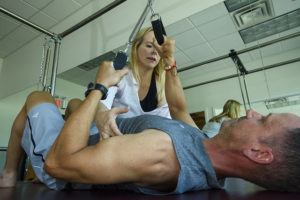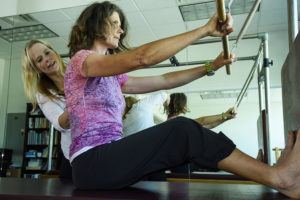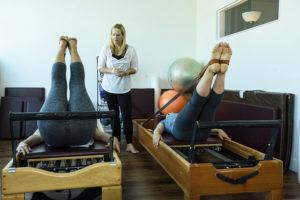Pilates for Back Pain
Back pain. For some it comes on like a lightning flash, making movement of any kind all but impossible until it subsides. For others, it’s a long-suffering ache that colours every aspect of life. The experience of chronic low back pain is likely as different between individuals as fingerprints. Treatment options are varied too: exercise therapies, physical therapies, chiropractic, pain treatments & medications and surgical interventions.
 Pilates is an option many people choose to reduce their low back pain and improve function. How effective is it, really? To answer that question, we have to be really clear about what it is we want and expect from a Pilates exercise program. In my experience though, the Pilates Method can be a pivotal tool in helping people get back to full movement in their lives. Here are a few things to think about if you’re looking to Pilates to help you with low back pain:
Pilates is an option many people choose to reduce their low back pain and improve function. How effective is it, really? To answer that question, we have to be really clear about what it is we want and expect from a Pilates exercise program. In my experience though, the Pilates Method can be a pivotal tool in helping people get back to full movement in their lives. Here are a few things to think about if you’re looking to Pilates to help you with low back pain:
About Back Pain
There are distinctive kinds of low back pain that will require different approaches for treatment and exercise. In some cases, a specific pathology of the spine is present, like a vertebral fracture or cancer in the spine. Sometimes, compression of a nerve root, or irritation of a nerve pathway causes back pain. More often than most, low back pain can be chronic and non-specific. A clinical definition of chronic low back pain (CLBP) is pain in the posterior lumbar area that lasts more than 12 weeks. Exercise interventions can be useful for all of these conditions, but the timing, exercise choices and intensity may be different for each one.
Chronic back pain is serious stuff! In Canada, chronic low back pain ranks among the highest reasons for physician consults in people under 60 years of age. It is one of the leading causes of years lived in disability around the world. Back pain conditions can have a profound effect on your movement, your fitness, your relationships, your health and overall quality of life. Whether your back pain is due to a specific pathology or whether you’ve had a “bad back” for a while, it’s always prudent to seek medical advice before embarking on a new program of physical activity.
Why Pilates is Good for Back Pain
 Back pain has long been associated with dysfunction and weakness of the body’s deep system core; which is made up of the transverse abdominus (deep abdominal muscles), the multifidus (deep back muscles), the pelvic floor muscles and the respiratory diaphragm. Pilates works to increase the tone, stamina and strength of these muscles through as full a range of motion as possible. The exercises lengthen and stretch the lumbar spine and hip flexors, which can help to decompress the joints and promote more optimal alignment of the spine and pelvis. Regular training can result in changes in posture, and improvements in the felt-sense control of the trunk and its relationship to movement of the limbs. Just learning to “brace” the spine can be counter-productive. Learning to support your whole structure well through a comprehensive range of motion creates greater access to fuller, more enjoyable movement in life.
Back pain has long been associated with dysfunction and weakness of the body’s deep system core; which is made up of the transverse abdominus (deep abdominal muscles), the multifidus (deep back muscles), the pelvic floor muscles and the respiratory diaphragm. Pilates works to increase the tone, stamina and strength of these muscles through as full a range of motion as possible. The exercises lengthen and stretch the lumbar spine and hip flexors, which can help to decompress the joints and promote more optimal alignment of the spine and pelvis. Regular training can result in changes in posture, and improvements in the felt-sense control of the trunk and its relationship to movement of the limbs. Just learning to “brace” the spine can be counter-productive. Learning to support your whole structure well through a comprehensive range of motion creates greater access to fuller, more enjoyable movement in life.
Improving back pain goes way beyond pure biomechanics. At its finest, Pilates provides an educational component too. This learning component helps people to understand what works best in their bodies, in the environments they live and work in, and with the movement tasks that are most meaningful for them. Pilates training can offer individuals useful strategies to get out of trouble if stiffness and pain return. Working with a knowledgeable Pilates teacher in an environment that feels safe and supportive can also provide important psychological support at a time when many people are feeling most vulnerable.
Pilates can also offer a perfect setting in which to re-pattern overactive pain signals in the brain. The brain can sometimes hijack normal transmission pathways for sensory information and begin to create pain signals instead. By creating successful, pain-free movement experiences, it is possible to re-wire patterns that cause the brain to interpret normal movement as a threat, and activate all the body’s protective mechanisms. By gradually building control and capacity through a tolerated range of motion, Pilates builds confidence that movement is safe and possible. Once people begin to feel that for themselves, the experience of movement becomes a whole different thing. Building strength through repetition then becomes the easy part.
What the Research Says
In the last decade or two, the Pilates method has moved from being an esoteric fitness choice to a popular rehab tool among therapists and medical practitioners worldwide. There has to be something to it, right? If we dig in to the research though, many studies about the effectiveness of Pilates for decreasing pain and improving function show conflicting results. Some studies enthusiastically support the use of Pilates; others say that all similar exercise is effective; some say that Pilates improves function but not pain; some say it improves pain but not function. I’m not exactly sure why the conclusions diverge so wildly. Perhaps it’s sample size, perhaps it has to do with method or timing of delivery… I don’t know.
There is also research that challenges whether core training itself has any validity in preventing or rehabilitating low back pain. As a Pilates and Integrated Movement Specialist, I can tell you that those studies threw me for a loop at first. There is actually little evidence to show that strengthening individual components of the core contributes to better stability for the spine. It seems that building capacity in the core musculature is important, but not on its own. In my experience, the core must be addressed in relation to other structures and systems in the body. As new research about fascia and connective tissue emerges, we are learning more about the interconnected relationships of all the body’s different systems. I suspect that the answers to some of the differing conclusions in the research may lie in evolving understanding about connections between the musculoskeletal structure, the fascial system, the nervous system and the brain. The body is always teaching us more!!
The “Back Whisperer”
 Several years ago, I read an article by a woman who had endured decades of chronic pain with associated medical and surgical interventions and drug treatments. Still, she suffered. For her, the final solution to her pain came with movement; through work with someone who helped her negotiate her way through the pain signals to build strength and stamina. She called this person a “back whisperer,” and the term really resonated for me. In my experience, it really is all about listening to the body, making some propositions about movement, watching what happens, listening again and moving forward as the body permits. Regardless of fancy protocols – everyone is a little different, and needs special individual care.
Several years ago, I read an article by a woman who had endured decades of chronic pain with associated medical and surgical interventions and drug treatments. Still, she suffered. For her, the final solution to her pain came with movement; through work with someone who helped her negotiate her way through the pain signals to build strength and stamina. She called this person a “back whisperer,” and the term really resonated for me. In my experience, it really is all about listening to the body, making some propositions about movement, watching what happens, listening again and moving forward as the body permits. Regardless of fancy protocols – everyone is a little different, and needs special individual care.
Ultimately, the real back whisperer is YOU. When you’re paying attention, you know your own body better than anyone. But having the support of a dedicated and knowledgeable professional to select appropriate and progressively more challenging movement, and to walk you through the ups and downs of recovery is key. A comprehensively-trained Pilates practitioner is often a good fit!
Pilates for Back Pain
Pilates can be a safe and effective movement choice for many people dealing with low back pain. With regular practice, you will gain strength, stamina and mobility in your body. You’ll begin to let go of excess tension in your movement as you explore more efficient strategies. You’ll expand your range of motion as your body starts to feel better organized and integrated. Things that once felt difficult will start to feel easy.
Gradually your pain will begin to dissipate. At first, it may just feel as though your body is looser and more relaxed after class. Then you’ll notice that you’re starting to feel a little stronger in different ways. Your posture will start to shift, and you might notice your clothes fitting differently as your shape changes. Then you may notice that without even thinking about it, you do something physically that once might have been painful. You run up a flight of stairs without planning to do it. You lift a toddler without a second thought. You can sit through a meeting at work, or get back to full-strength in an favourite sport. The pain-free milestones will start to add up over time.
 If you think you’d like to try Pilates for your own back pain, here are a few guidelines to help you get what you need for a successful experience:
If you think you’d like to try Pilates for your own back pain, here are a few guidelines to help you get what you need for a successful experience:
- Contact a qualified Pilates professional who has experience and up-to-date information about pain and injuries. All Pilates is not created equal – do your homework! Get references and talk to the instructor before you start to make sure you’re a good fit. Trust is important. Find someone who will LISTEN to your story, not just tell you what you have to do.
- Start with private sessions. Your instructor should do a comprehensive assessment of your posture and movement. Ideally, there will be some discussion about your history, your goals, and more. Together, you and your instructor will build a Pilates program that feels do-able and good in your body! Talk to your instructor regularly about what feels good, what feels challenging, and how you feel in between sessions.
- Once you’ve got some positive stuff happening, it may be possible to move to a group Pilates setting, as long as it supports and further develops the work you’ve done in your private training. Some Pilates studios offer open-gym type group workouts, where each person works through their own program under the supervision of a teacher. Some studios only do instructor led classes, where everyone in the room is following a teacher’s instructions. Each have their benefits: know before you go!
- Understand that where the pain is may not be where the problem is. A good movement specialist will dig into what might be driving dysfunction and pain in the body. The dysfunction in your back may indeed be the result of a weak core system; but that dysfunction may be driven by something going on in your hip, or your thorax, or your shoulder! If you’re always going after the obvious choices with little change, there is likely something else going on. Pay attention to what feels good, and what’s happening when the wheels fall off.
- Commit to mindful and consistent practice. Understand that a class here and there is not going to solve your problems. If you are serious, be prepared for at least 6 months of regular training to get you over the hump. I recommend more in many cases – but less than 6 months may be just a temporary solution. Remember: you’re not just training muscles. You are deconstructing habitual patterns and rebuilding a whole new network of possibilities, and strengthening those! That takes time. If you’re not experiencing some degree of better within a month or two though, something is not working. You should have some tangible sense of progress in that time, even if you’re not feeling completely better.
- Doing Pilates for this purpose often costs more than a membership for group classes at the local gym. If finances are an issue, talk to your instructor about possible options. Consider your priorities! If you’d spend money on a holiday or a new bike but balk at the idea of paying for physical training, understand the choice you may be making. How valuable to you IS your mobility? I’m not prepared to put up with pain and dysfunction that I can do something about. Are you?
- If your instructor gives you stuff to practice or observe when you’re away from the studio, do it! Bringing awareness to your movement patterns and support strategies in your daily life is important. Building fundamental skills and strength takes lots of quality repetition and practice. Learning about your own movement habits helps you to explore opportunities for more optimal choices, and can help your instructor get more specific about strategies that may help.
- Even if you’re a monster of fitness by every other measure, your back pain indicates that something is awry. You may have compensations in your body that have been accumulating for years. Your teacher may work with weight loads and ranges of motion that feel too easy at first. When that happens, we’re looking to load the deep system in a way you’re not used to doing. Nothing new happens if you keep doing things the same old way! We may make exercise choices that don’t immediately make sense to you. Every movement in your program has a purpose. If you don’t understand, ask.
- Move. And move some more! Beyond your Pilates training, look for every opportunity you have to move. Progress may feel slow at first, but as you gain capacity, you’ll be ready for so much more. You might actually find movement that wasn’t possible for you even BEFORE the onset of your back pain. The more varied your movement experiences, the more strength and resilience you build into your system.
- Don’t forget to play! Sometimes the process of “rehabilitation” can take us to a place where we are constantly “working on” something. Yes, be diligent. But find the fun too! You are more than your pain or your condition. What are the things that bring you joy? Make room for those things too.
Whatever path you choose to deal with your back pain, my advice to you is to stay engaged in the process. You are the common denominator, and you have more power over your own situation than you imagine possible. Yes, it takes time. But you’re worth it.
If you’d like more information about Pilates for Back Pain, check out our Getting Started Guide. We have Pilates and Integrated Movement programs designed to support you every step of the way. Book an Introductory Private Training Package today.
Have you tried Pilates for back pain? How did it work for you? Share your story in the comments section below!
 About Susannah Steers
About Susannah Steers
Susannah is a Pilates and Integrated Movement Specialist, and owner of Moving Spirit. Through movement teaching, speaking, and workshop facilitation, she supports people in creating movement practices that promote fitness and ignite vitality, creativity and connection. She is co-host of The Small Conversations for a Better World Podcast.
If you liked this article, here are a few more that you might find useful:
Pilates: One Man’s Success Story
Core Stability: What is It, and How Do I Get it?
8 Steps To Integrating the Core: There’s More To It Than Muscle!
